In 20 years of interviewing actors, musicians, designers and artists, my audience with Pat McGrath has been the most difficult. Not because she’s chilly or aloof (she’s tactile, warm, prone to outbursts of laughter and the lavish use of “darling”), but because not a minute goes by without a passerby interrupting to tell her how much they admire her, and to my frustration, she spends much of our precious allotted time indulging them.
The Guardian’s product and service reviews are independent and are in no way influenced by any advertiser or commercial initiative. We will earn a commission from the retailer if you buy something through an affiliate link. Learn more.
“You look beautiful, darling,” she purrs to one beauty blogger, as worried publicists look on impatiently. “Let me get someone from my team to do your makeup! It’ll be gorgeous on you,” she says to another. She stops again to pose for a photograph with actor Olivia Palermo (who seems under no illusion that she might be the main attraction here), then again to reel off some social media content and to check an assistant has her trainers. By then our “intimate chat”, in a bustling Parisian penthouse, is rather up against it, because McGrath is due to get on a motorbike to the Ritz, where an unnamed celebrity is waiting to be made up for the red carpet.
She promises a follow-up within days, and so begins almost a fortnight of postponements, briefing calls, time-zone complications and several profuse apologies as beauty’s biggest hitter paints, dusts and blends her way across dozens of faces and two continents. Truly, I have interviewed more accessible Oscar winners.
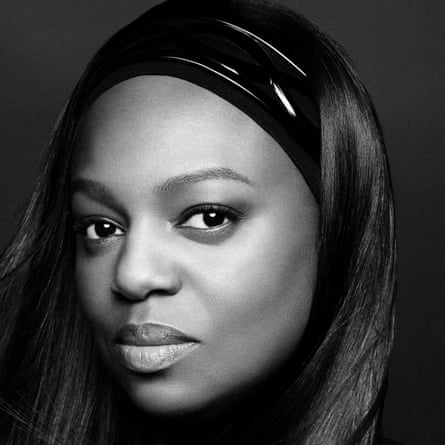
The reason I’ve been granted this extremely rare face time with the world’s most influential makeup artist is that she’s just launched her eponymous makeup line, Pat McGrath Labs, in Europe. The brand has already smashed the US, where McGrath lives in two New York West Village apartments, one above the other, though she is barely ever in either. She’s mostly on the road, working on magazine covers for the likes of Vogue, Harpers and W, the faces of celebrities such as Rihanna and Kim Kardashian, on advertising campaigns for Versace, Prada, Louis Vuitton and Gucci, and designing the makeup looks for around 80 major fashion shows per year (she is widely acknowledged as the most prolific catwalk makeup artist of all time). She travels from one fashion capital to another with dozens of makeup cases and a huge team of between 25 and 90 devoted artists to carry them all. “The most we’ve ever taken is 87 trunks,” she tells me. “I’ve collected everything for about 25 years. I’d go into a department store now and buy everything. It’s who I am. I just love cosmetics.”
McGrath qualifies this by telling me that she has filled 4,000 square feet of storage with products and says “You couldn’t get anyone more makeup addicted than me”, perhaps because she knows her passion for face paint isn’t immediately apparent. Much like the most celebrated fashion experts wear only black (she does, too – today she’s in a long black skirt, matching shirt and her signature wide black headband), the world’s top makeup artist doesn’t appear to be wearing the stuff herself. “I wear very natural makeup but it’s made up out of five foundations to make that perfect skin and my lipstick might be three different lipsticks mixed together, so it’s a kind of obsession in a different way,” she laughs.
If beauty is McGrath’s addiction, her single mother was her pusher. McGrath was raised in Northampton by Jean, whose love of God was matched only by an extraordinary fascination with everything fashion and beauty. From as early as McGrath can remember, working class, Jamaican-born, Jehovah’s Witness Jean was schooling her in advanced aesthetic awareness. “My mother was obsessed with makeup,” she says. “She would stand in front of the TV and we’d have to guess what she’d done differently with her eyes. I’d think: ‘Get out of the way!’ But she wouldn’t move until I’d told her.” Together they would analyse the makeup looks of Old Hollywood film stars, identifying which had inspired fashion designers that season.
Jean encouraged McGrath to be creative with makeup, mixing pigments from scratch to get exactly the right colour, adding heat to the skin with her fingertips to give it a healthier glow and soften the look of foundation. She explains: “She always put on a full face of makeup then got in the bath to get that dewy finish. It was next level, but this is where I got my makeup tips from – at seven years old!” Together, Jean (a talented dressmaker) and McGrath would go and look at Vogue patterns, then off to the market, where all the fabric buyers sold their remnants, before deciding which makeup would best go with the clothes.
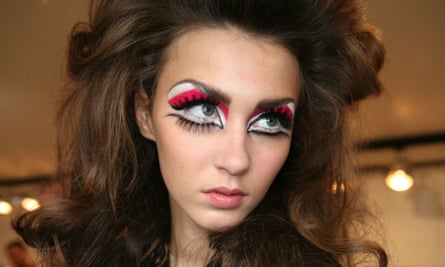
Whether they could find makeup to suit their skin colour was another matter entirely. To say women of colour were under-served by beauty brands in 70s and 80s Britain is a woeful understatement. “There was no makeup for women of colour,” she reminds me. “NOTHING. That’s what my mother’s search was all about. When we were out shopping we were always looking for a product that, probably by accident rather than design, worked for us. Where there was no ashiness, no ‘white cast’ [an effect commonly caused by talc in caucasian-skewed makeup], probably from some makeup line that had either discontinued it or gone bust.”
She concedes that this may be why she initially became known for colourful and avant-garde makeup, rather than for the “nude” shades that were so popular in the late 80s. Back then the dominant makeup look was matte and flat textured, created with products that had insufficient pigment for darker skins, which gave skin a sculpted but almost lifelike quality. Then, as sometimes even today, the word “nude” was commonly used as a euphemism for tones present in caucasian skin.
The teenage McGrath was drawn to looks that were a little leftfield, and got her big break “while stalking Spandau Ballet outside Radio 1”, wearing new romantic garb and bold lipstick on her eyes, cheeks and lips. She was spotted by presenter Janice Long, who pointed at McGrath’s face and asked: “Will you do that on me?” She recalls: “I didn’t even know that was a job. She said it was, so I went home that night knowing what I was going to do with my life.” She later moved to London and through the club scene, got her break doing makeup for Soul II Soul, who appeared frequently in the credible fashion press. Soon she was working for the Face and i-D, where 18-year-old stylist Edward Enninful had just been made the industry’s youngest ever fashion director. The two became close. Her bold makeup translated well into his striking photo shoots and stood out during the 1990s grunge era, when makeup was often downplayed to the point of non-existence.
It proved to be just one of many hugely creative and influential collaborations in McGrath’s career (she has been the go-to makeup artist for designer Miuccia Prada and photographer Steven Meisel for years), but is the longest and perhaps the most personal one. Both Enninful and McGrath describe the other as their “best friend”, and a few days after we meet, it’s announced that she is to be beauty editor-at-large at British Vogue, where he took the helm last week (the first man, and first person of colour, to do so). This explains why she remains so tight-lipped when I ask what she thinks he might change at Vogue, only assuring me that he will do great things. “Of course he’ll do amazingly!” she almost bellows. “He’s lovely. I remember when I first met him, when he had just started working at i-D, and he was so shy. He’s so quiet when he speaks, but now he says: ‘I’ve become loud because I’m with you’,” she laughs, before adding, more seriously: “I’m so proud of him, it’s amazing to see.”
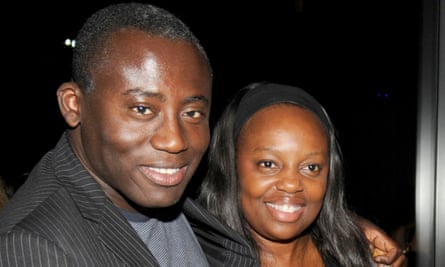
The appointment of Enninful, a British Ghanaian, is seen by many as a sign that mainstream fashion media – where black cover stars and senior staff members are still exceptional – is finally becoming more inclusive. McGrath is cautiously optimistic. “I think you always want things to get better and that’s been my view ever since I’ve been in this industry. So it’s great to see there’s more diversity, but it could always get better.”
She concedes that her side of the industry is as culpable. “It’s the same with the beauty companies because there is a whole planet out there. How can you not address the whole world – what are you thinking?” She is determined that no one should have to do what she and her mother (who died in 1992, as her daughter’s career was taking off) had to, and mix their own colours to match. For Pat McGrath Labs, she explains: “I was working all the time with pigments to make sure they work on all skin tones, particularly to make sure dark skin doesn’t become ashy, pigments that are so rich they work on everybody. Because a lot of the time when you buy a normal shadow, it doesn’t always work on every skin tone – it’s chalky or too light – so that’s my main aim, to bring makeup for all skin tones to the fore.”
She’s interested in diversity in colour, but also in shape, size, gender classification, and for her own brand, has made a point of using models of different types. “It’s about pushing boundaries. I believe absolutely, the world wants something different, people want back their individuality.” Despite working with mainstream stars such as Cara Delevingne, Bella Hadid and longtime friend and collaborator, Naomi Campbell, McGrath’s public approbation has made stars of African-American writer, model and “plus-size” body-positive pioneer Paloma Elsesser; Jason Dardo, the American drag queen and burlesque dancer (otherwise known as Violet Chachki), and gender fluid model, former RuPaul drag race contestant and makeup artist Kurtis Dam-Mikkelsen – all of whom she discovered while browsing Instagram.
Beauty is quite technical, quite nerdy now. So it’s my time, because I am that woman
All of them stretch the beauty industry’s notoriously narrow perimeters. She’s proud of all her young collaborators. “I remember when I first saw Paloma on Instagram. I reached out to her and she became one of our muses and now that she’s working for so many brands, it’s so inspiring. I’m just so happy that all of my girls, and my boys as well, are doing so well. I’m watching what’s happened with Miss Fame (alter-ego of Dam-Mikkelsen) getting a contract (with L’Oreal) – these genius young people who started out with me and now they’re fronting beauty campaigns, or getting tons of editorial work, and it’s amazing to see how well they’re all doing, it’s brilliant”.Social media was a turning point for McGrath. It’s fair to say Instagram and YouTube have done for makeup artistry what MySpace did for music, giving young beauty talent a global showcase, as well daily access to, and inspiration from, the world’s biggest established artists. Thanks to the photo-sharing app (on which she currently has 1.4 million followers, a number matched only by fellow British artist Charlotte Tilbury), McGrath’s appeal has expanded way beyond the once insular world of high fashion. Does she mind that nowadays, seemingly everyone on Instagram wants to be a makeup artist? “No, I think it’s amazing”. She follows upcoming artists obsessively, reposting their images, even asking them to join her team. “They encourage me, I encourage them. A lot of my team met through social media. We had a contest called Backstage with Pat McGrath, which had 30,000 entrants and we chose 40 people to come and experience what’s it’s like on the road when we’re doing shows, and they just loved it. I met some brilliant people.”
Pat McGrath Labs taps into what beauty conglomerates are only just realising: the power of the online beauty geek. These makeup obsessives – men, women, young, old, black or white – reside in the sparkliest corner of the internet and revere beauty as high art. These are the fans who wait at their computers for a big product launch to “drop” at 6am, and who can, in all likelihood, namecheck studio system makeup artists, forgotten 1930s burlesque stars and the exact shade of Marilyn Monroe’s hair colorant (Dirty Pillow Slip, since you ask).
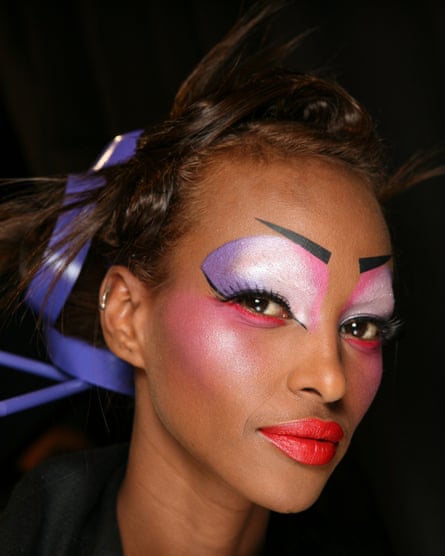
Everything about McGrath’s launch was geared towards this community of anoraks, and capitalises on the internet’s ability to take what would constitute an unworkable niche in local territories, and make it a hugely successful global concern. McGrath’s first, and for several months, only product, was Gold 001 – a single, dry, metallic pigment that liquified with a special mixing solution. Launched on limited, numbered release and advertised only through McGrath’s social media accounts, it sold out in six minutes. “I was so overwhelmed,” she says. “I had only planned to do it as a one-off for fun, for the makeup addicted fans. Suddenly I was getting phone calls from around the world.”
Now, four times a year, another new professional-grade product – a holographic eye gloss, almost neon blue shadow, a balm stick and nude pigment for achieving McGrath’s signature “hyper-real skin” (formerly achieved by layering several different consumer products), is launched to similar frenzy. Each is encased in simple plastic factory packaging (“No weights, no metals,” she says, “the jewel is the product itself”) to keep down the already high price (from £55 in the UK, $40 in the US). Neither seems to put buyers off – in fact, many apparently never open their sequin-stuffed ziplock bags to fish out the product itself, preferring to keep their precious collector’s item pristine.
In this Instagram age, says McGrath, the number of beauty obsessives is vast. “People don’t want to be bored any more. They really do want to try new things. I know from talking to my girlfriends who aren’t even in the industry, the way women speak about makeup is no longer: “Ooh, look at this lovely mascara.” They talk to me as though I’m in a lab, using a thousand words to describe it. It is actually quite technical, and I do believe people love what they see at the fashion shows and editorial, and want to try it. It’s now a nerdy approach. And so it’s my time, because I am that woman. Now, ‘the makeup obsessed’ is everybody. An air stewardess recently told me her eight-year-old daughter watches complex how-tos on YouTube.”
Many of McGrath’s most outlandish catwalk looks have quickly become crossover hits. Dense, glittery eyelids with thick black brows for John Galliano, opaque gold lips at Prada, chunky, stick-on face jewels for Givenchy, metallic highlighter everywhere from Dior to Versace – all were copied by high street brands, and adopted widely.
But while the beauty industry was happy to copy McGrath’s looks (or even engage her as a consultant – she has helped to create products for Giorgio Armani, Max Factor, Dolce & Gabbana and Cover Girl Cosmetics), most weren’t confident in selling the real thing. “I spoke to makeup executives about my own line for the past 15 years and they’d say: ‘You know, nobody knows you, nobody really wants the kind of stuff you do in shows in real life.’ And then I joined social media and all I’d hear from thousands and thousands of people was that they did.”
She has no time for industry snobbery over social media beauty trends, such as contouring and dark, painted-on eyebrows. “Just the fact that people love makeup is wonderful. If you want to be out there in a thick, black brow, then go there, girl! But at the same time, people love it when they’re shown exactly how to do it well. Not everyone’s going to do things perfectly but the fact that people are trying, and are excited by cosmetics, always means something to me.” She’s all for clearing the smoke and mirrors of the fashion world. “When I remember how much joy the fashion industry brought to me, how I’d watch the 50 seconds of catwalk footage, twice a year at the end of News at Ten, and get goosebumps, well, it was life-changing. Imagine as a young kid now getting to see everything they’re seeing? It must be so inspiring.”

Nowadays, she finds inspiration by obsessively studying films, art history and photography. She insists she enjoys the pressure of having to come up with 80 or more entirely new concepts annually for the shows. “I love to be challenged. I can spend a good hour or two (in makeup trials) trying to make some concept a reality. But that’s what I enjoy the most, I love it.”
Isn’t it exhausting? “I always lose my voice by the end of show season,” she says, “but this is something I’m obsessed with, something I’ve always wanted to do. It brings me joy. When you’re at shows, there’s a nervous energy. You want to make everything that you do perfect because can you imagine seeing the clothing I get to see on a daily basis? It’s exquisite, so the last thing you want to do is have the makeup let that whole collection down. It’s pressure, but I love it”.
Back in Hotel Shangri-La, McGrath is now more than an hour late for her celebrity appointment and as she promises me another chat, we are interrupted yet again, by a young woman wearing red lipstick newly daubed in dense, sparkly glitter from Pat McGrath Labs. Her mouth looks like Dorothy’s ruby slippers, her eyes are almost tearful with happiness at meeting her idol. McGrath grabs her warmly by the shoulders and squeezes. “Oh my God, look at that lip! Isn’t it gorgeous? Wait till you go in daylight, it’ll be amazing!”
Pat McGrath Labs is available now, exclusively at Net-a-Porter.
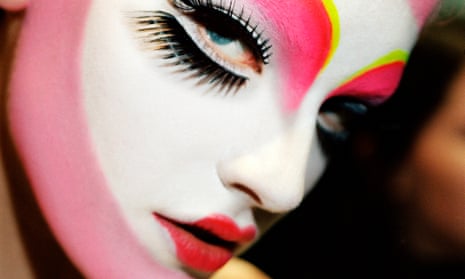
Comments (…)
Sign in or create your Guardian account to join the discussion